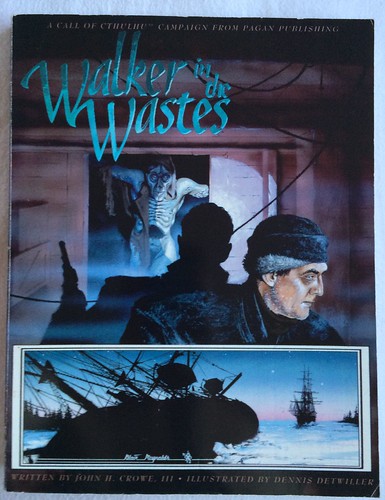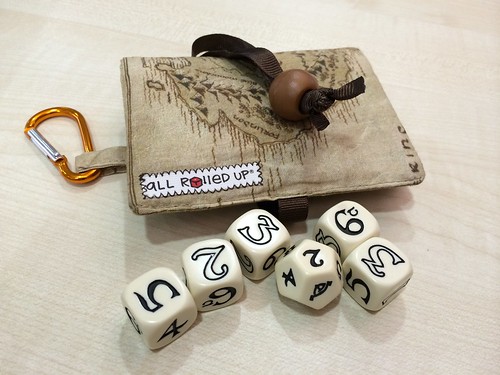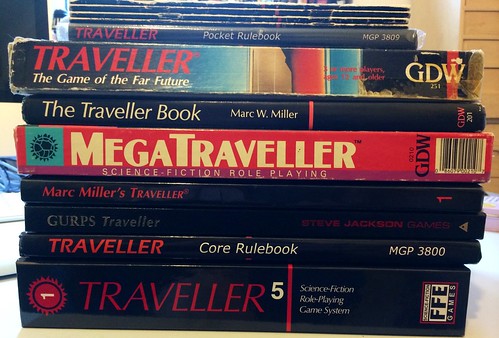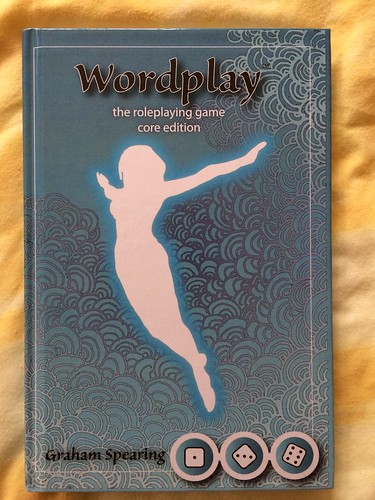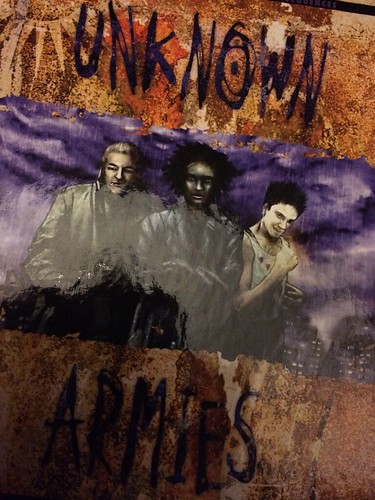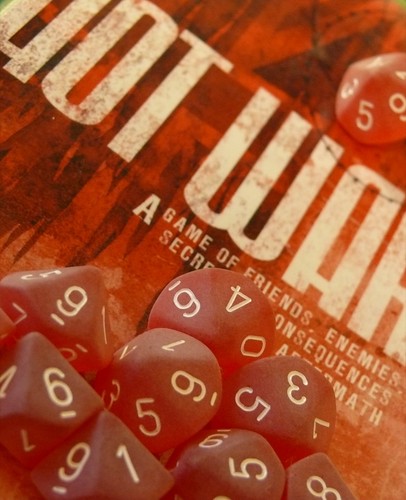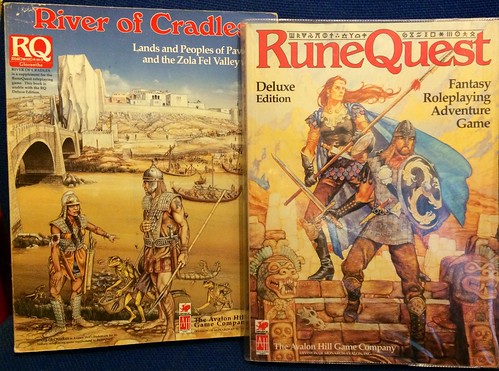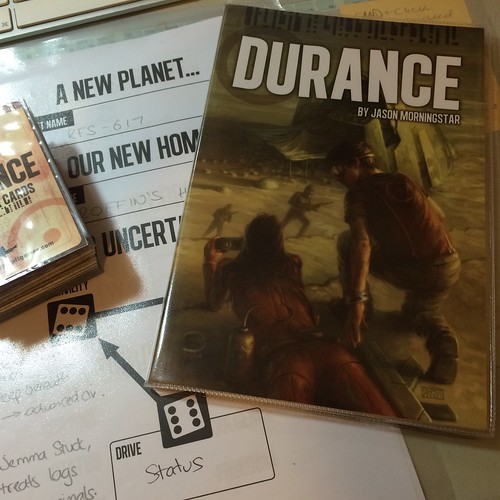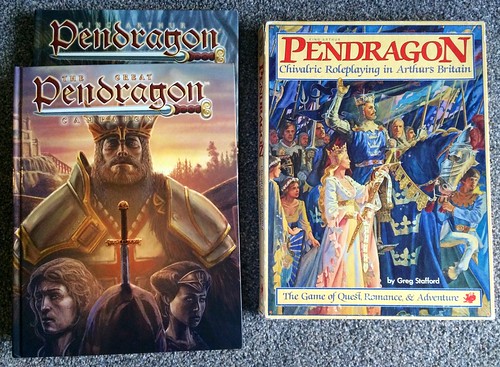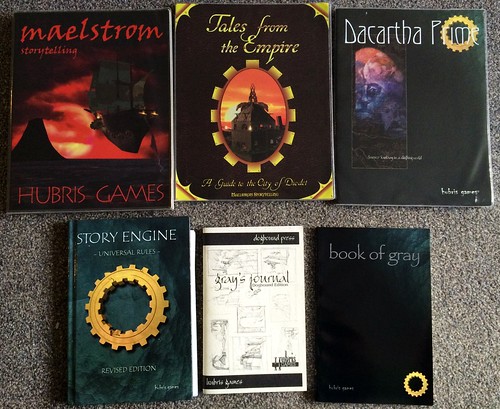Today I saw the final part of Peter Jackson's adaptation of JRR Tolkien's The Hobbit, a story that I love and have cherished since I was a child. All in all, I found it a satisfactory conclusion.
Yes, the battle sequences were long and drawn out - in many ways mirroring the approach in The Lord of the Rings’ third part, but they were offset by the moments of humanity in the film with the fall and redemption of Thorin Oakenshield from the dragon-sickness for gold and the conversations involving Bilbo Baggins.
The visuals seemed to be channeling Warhammer, especially with some of the creatures used for steeds and the looks of Dain Ironfoot. Looking at the references in Foster's Complete Guide to Middle Earth, and searching on "Dain”in The Hobbit and Unfinished Tales gives no really hint of Dain's character beyond the fact that he was a doughty and determined warrior who finally fell at the Battle of Dale during the War of the Ring next to his compatriot King Brand1. I guess that this means that this interpretation is as good as any, and in some ways, having Billy Connolly playing him as a Scottish Dwarven Hard-man was an act of inspired genius.
I started to watching the first part, An Unexpected Journey again tonight, and it showed much more of a consistency of characterisation than I recalled, especially around Thorin, the dragon-sickness, honour and bravery. I may revisit these notes after I have re-watched the whole sequence.
Fundamentally, film is a different medium to a book, and what makes a good book doesn't necessarily make a good film. Slavish adaptations often fail. At times, Peter Jackson does push it too far for my liking - the Goblin Town sequence in the first film, the barrel ride sequence in the second, Legolas the Super-Hero, but I suspect that these were aimed at a younger audience than me. They certainly delivered thrills and a counterpoint to the darker parts of the film. However, overall I loved the visuals and the exploration of a tale that I and my eldest love dearly.
I entitled this post Tolkien Cinematic Universe for a reason; the recent Marvel films are referred to as the Marvel Cinematic Universe as they have not followed the existing canon slavishly but have still had a recognisable validity and similarity to the original published works. I think that Jackson's films hit exactly the same spot; lovingly created, but only related to the original.
27 December 2014
1. I’m not ruling out further descriptions of Dain Ironfoot in the ephemera of Tolkien that followed Unfinished Tales from the Book of Lost Tales onwards, but in honesty I gave up on delving deeper into the Tolkien canon at that point. The depths nearly always end up with bad things happening, like Balrogs or Dragons. ↩
27 December 2014
08 December 2014
Simple Minds - Big Music
I’m pretty excited about Monday’s release of a new Simple Minds album, more so than I have been for a long time. From the snippets that I have heard, it’s a definite nod to their earlier style (pre-stadium rock).
Simple Minds were the first band that I saw live, driving over the Pennines in my mum’s old Mini Clubman (we’re talking 1989 here, so it’s a small car rather than the current Giants) with several of my friends to see the concert at Roundhay Park in Leeds, around the time of Streetfighting Years. I can’t remember exactly who I was with, and the photos from the day are in storage too, but I think it may have involved Mike S, Christine M, and possibily Caroline R, Liz M and Nigel McN), but I do remember that it was a long day, but great fun.
Simple Minds are one of the best live acts that you will see, whether it is at a small intimate venue or a stadium. They have an ethos that you’ve paid to be entertained and they make sure that they put on a good show. So much so that when I saw U2 on the Zoo TV tour at exactly the same venue a few years later it was a disappointment and definitely overhyped!
I first found the band through the Once Upon a Time album, which was a loan from our local library (and I eventually bought the Vinyl and a cassette of it from them when they cleared it as surplus stock). Naturally, the vinyl got copied to cassette before that as I loved it, and I probably drove my parents mad singing along (badly) to ‘Ghost Dancing’, ‘Oh, Jungleland’ and ‘All the Things She Said’. I used to play this loud before exams to calm down, something that probably annoyed Jon H and others who shared a house with me.
I very quickly found the older albums recorded in their Arista days, like Life in a Day, Reel to Reel Cacophony and Empires and Dance, and really liked their more synth driven style, but the record that really hit a mark was New Gold Dream (81-82-83-84) which includes some of my favourites like ‘Hunter and the Hunted’, ‘Someone, Somewhere, In Summertime’ and ‘The King is White and in the Crowd’. Synth driven slinkiness with a hint of rock.
Sons and Fascination / Sister Feelings Call - packaged as a double album - sat between Empires and Dance and New Gold Dream, and has some fantastic tracks such as ‘Theme for Great Cities’ and ‘Love Song’. They still feel modern and raw.
Sparkle in the Rain, which includes ‘Waterfront’ is the transition record to ‘Once upon a Time’. I have to say that it’s an album I need to be in the right mood for.
Most people who know Simple Minds from their stadium rock era will be thinking of ‘Don’t you (forget about me)’ – as written for the brat pack movie ‘The Breakfast Club’ and not by Kerr/Burchill and friends – and ‘Alive and Kicking’ or even ‘Belfast Child’ or ‘Mandela Day’. The earlier materual will be a bit of a shock but it’s worth a listen.
My first CD was the double disc Live in the City of Light, which is a cracking recording of two nights in concert in Paris during the Once Upon a Time Tour.
Street Fighting Years shifted in style, more openly political, and I overplayed this in Sixth Form. It also marked a shift in perception of the band; they dropped from being ‘cool’ as indie and Madchester were hitting but frankly, I didn’t care. Real Life came out when I was on my year out working before University. I played this a lot in the long haul up from Cheshire to north Cumbria, and I associate it very much with this drive[1]. I think the album is under-rated and it remains a favourite.
The next release was Good News from the Next World, which I mainly remember from the fact that I was in bed for two weeks with chronic Bronchitis at University and my then-girlfriend Sarah went out and bought it for me. It’s very listenable, but not hugely memorable.
I actually missed the fact that Néapolis was being released, stumbling upon it just after I finished University in the Asda in Bromborough. I quite liked it again, but it hasn’t been one I want to go back to. In fact, I started to wonder whether I would bother to buy another album if it came out.
The band then seemed to disappear. I didn’t know at the time, but they had an album prepared - Our Secrets are the Same - but it wasn’t released until the Silver Box collection due to record company politics. I can’t remember how I found them again, but I bought the CD of Cry soon after it came out, and loved the more modern style in it. Caught them touring part of this in Liverpool as well, and Jill & I used ‘New Sunshine Morning’ and ‘One Step Closer’ in the mix for our wedding. In fact, the latter was our first wedded dance.
The next release was Black and White 050505, which again seemed another step back towards form, removing some of my doubts. However, Simple Minds had definitely fallen behind Marillion in my pantheon of favourite bands.
Then, in 2009, Graffiti Soul was released, and was surprisingly playable. ‘Rockets’ was pop-tastic rock, and ’Stars will will Lead the Way’ had a killer guitar riff. As an album, in five years of owning an iPhone, it’s not been off the music stored in iTunes for on-the-go.
There was a greatest hits release last year (Celebrate), along with remasters of the first five albums, but I have to confess that I have ignored these. I may have a listen to X5 (the remasters) to see if the quality from the remix is worth replacing my existing versions, but the thing that excites me is the new album Big Music. The tracks that I’ve heard remind me of the early albums, but more polished.
So, don’t disturb me if you see me with headphones on Monday, because you know what I’ll be listening to.
For the record these are the original formats I bought:
- Life in Day - cassette
- Real to Real Cacophony - cassette
- Celebrate - cassette
- Empires and Dance - cassette
- Sons & Fascination - cassette
- Sister Feelings Call - cassette
- New Gold Dream (81—82-83-84) - Vinyl 45
- Sparkle in the Rain - cassette
- Once Upon a Time - Vinyl 45
- Live in the City of Light - CD
- Street Fighting Years - Vinyl 45
- Real Life - CD
- Good News from the Next World - CD
- Néapolis - CD
- Silver Box (Our Secrets are the Same) - CD
- Cry - CD
- Black and White 050505 - CD
- Graffiti Soul - Digital download
- Big Music - Digital download (subsequently CD)
8 December 2014
Update 27 December 2014
I’m really pleased with Big Music, and I have hardly stopped playing it since I bought it. This doesn’t happen that often…
____
[1]: Along with New Order’s ‘Substance’ and Depeche Mode’s ‘Violator’.
01 November 2014
Ten books which have stayed with you

Only missing “Rendezvous with Rama”, which is on Kindle as I foolishly lent out the original.
1. “The Hobbit" (JRR Tolkien)
I'm sure this book will feature in many people's top ten. "The Hobbit” was one of the first books that I read and reread regularly. Yes, its style is not as adult as "The Lord of the Rings", but it is full of joy and adventure, whereas the trilogy has always felt dark and doomed. I have to confess that "The Silmarillion" came very close to taking this spot as the shear epic feel of the sweep of history really hit the mark for me, despite it being difficult to read in some parts.
2. ”Downbelow Station" (CJ Cherryh)
CJ Cherryh writes character driven novels where the science fiction is almost incidental. "Downbelow Station" won the Hugo and the Nebula awards and is a book that I have returned to again and again, and is probably my favourite SF novel. Cherryh writes from the perspective of the character she is voicing, so you only ever know what they know. "Downbelow Station" is a story about the impact of war on people living at Pell's Station during the conclusion of a conflict between different human factions. Space battles, refugees, politics, and love are all in this, and I found the book nearly impossible to put down when I got it one Christmas. I can remember being at my grandparent's house and being unable to put it down. I can also recommend the audiobook, which - despite my having read the novel many times - revealed little details and nuances of the plot that I hadn't really dwelt on when I read it normally. Oh, and once you've read this, "Cyteen" is a must.
3. ”Rendezvous with Rama" (Sir Arthur C Clarke)
My Australian Second Cousin Kathy F gave me this book (along with another cracking tome on aircraft) when she left from staying with us, and it has stayed with me ever since. It's a story about humanity encountering an alien vessel and trying to work out what it is, what it does and whether the entry into the Solar System is just a coincidence. It's short compared to modern novels, and a great story of discovery. My only regret is that the original copy that I had was lost by someone who borrowed it. The BBC radio adaptation is also worth a listen if you can find it.
4. “Postmarked the Stars" (Andre Norton)
When I discovered Andre Norton at Holmes Chapel library as a young lad, I discovered science fiction and fantasy. The first novel in her free traders books "Sargasso of Space" had me hooked from the start with a tale of a young man joining a merchant trader and seeking his fortune in the stars. However, it's the third book in the series that stays with me and so I have named it here. This involved a colony world where all was not as it seemed. I still have the copy that I found at a bookshop in Cornwall or Devon on holiday, and I know that it has heavily influenced my love of the Traveller RPG. I have re-read this many times.
5. ”Winter's Tale (Mark Helprin)
Again, a book that I stumbled upon at the library, probably when I worked there as a Saturday assistant. Sadly, I've subsequently lost the glorious hardcover I had, but I have paperback and Kindle versions. This is a tale of love, of loss and of magic, set in a mythical version of New York. Peter Lake is a burglar who meets Beverly, a girl terminally ill, when he is breaking into her family's house and falls in love with her. Beautifully written, dreamy and evocative, it's not a book that I can read very often but it's one that I love very much. Recently filmed as 'A New York's Winter's Tale', which was a nice adaption.
6. “Neuromancer" (William Gibson)
I found this book - which I'd been looking for following reading a review in Dave Langford's column in White Dwarf - on a book stand while I was away at a Scout Camp. I think it may have been in Bala in Wales. It has stayed with me ever since (and got me into trouble with my father when I got it, as he didn't think it entirely appropriate for my age). It was the novel that crystalised a change in SF and I loved it. The vision it presents is bleak, but less technology obsessed than many of the roleplaying games in the same genre. The plot twists and Gibson's prose crackles with energy. I recently re-read this and had the chance to listen to the BBC Radio adaption which is fantastic.
7. "The Earthsea Sextet" (Ursula K Le Guin)
Le Guin's fantasy series is superb, and very different to many other fantasy series. I read this while at secondary school and loved it. I was even more excited when a further three books emerged over the years since I read it first, and one of my happiest book purchases was when I found the hardback edition so now I have a lovely set. It has meant that the original, well worn and loved, paperbacks can be passed onto Nathan when he is old enough.
8. "The Dark is Rising" Sequence (Susan Cooper)
I'm naming the whole sequence here, but if I had to choose one, it would be "The Dark is Rising". This is a darkly-lensed fantasy tale of a young boy who discovers that he isn't like the rest of his family and has special powers, and is drawn into an age-old conflict between the Light and the Dark. Starting in a family farmhouse, at the onset of winter, in our modern world, this novel was really evocative for me as it reminded me of the Cheshire countryside where I lived. This was an optional text for English at secondary school, but I went out and read all five books, and have done repeatedly. The film adaption, 'The Seeker', isn't brilliant. The film makers were a bit too influenced by Harry Potter.
9. The Merlin Trilogy (Mary Stewart)
This is the sequence "The Crystal Cave", "The Hollow Hills" and "The Last Enchantment". I was introduced to these by my paternal grandmother who was fascinated by the Arthurian legends, the Celts and history. The books very strongly influenced my view of the Pendragon RPG, which I always ran in a more gritty, less Mallory inspired mode. Mary Stewart weaves the Arthurian legend well, telling it from the perspective of Merlin. Her setting is in Greater and Lesser Britain as the Romans retreated, with the island threatened by the Saxons. It is epic, and - whilst told from the perspective of Merlin - the magic is mysterious and low key. It is almost believable. I have read this many times and will do again. There are two linked books; "The Wicked Day" which continues the story after "The Last Enchantment" with a somewhat sympathetic Mordred as a focus, and "The Prince and the Pilgrim", which I have yet to read, and is set within Arthur's reign.
10. "Mythago Wood" (Robert Holdstock)
A magical book, set just after the Second World War beside and inside a tract of primal woodland called Ryhope Wood in the south of England. The wood interacts and generate myth imagos representing the fears and hopes of the people who have lived in and around it. The world inside the wood is far bigger than it appears from the outside, stretching in space and time back thousands of years. The Huxley family get drawn into the world of the wood, full of conflicts and discoveries. The book is beautifully written, evocative and one I love to dip back into. There are a number of sequel/prequels which are also worth considering.

Missing the original Foundation Trilogy, which I am not sure where I’ve stored it!
This post grew from a meme on Facebook, which I found very difficult to finish as there are so many books that have meant so much to me over the years. There were several that - had I been in a different mood - would have made the cut, so I decided to give them an honourable mention.
The first was “Eagle of the Ninth” and its various sequels (“The Silver Branch”, “The Lantern Bearers”, “Frontier Wolf” ) written by Rosemary Sutcliff. Set in Roman Britain, these really fired my imagination (especially with the Legionnairy Fortress of Chester nearby) and impacted upon both my interpretation of Glorantha and the Pendragon game settings.
John le Carré didn't make the cut because although I love his work and will seek out and buy a new novel the moment it is released, I rarely re-read his books. However, his recent novels starting from “Absolute Friends” have been on fire, and he has been griped with a passion and anger that was absent post Cold War.
Isaac Azimov's Foundation Trilogy was a huge influence on me from an early age. My father had a copy of the Pan release with black covers and abstract shapes, and the epic scale of the tales resonated with me. Yes, the characters can be cutouts, but the overall scope is great. The expanded books are also good, but not in the same league for me.
Much as Chester influenced my love of Rosemary Sutcliff's Roman Britain books, another part of Cheshire is entwined in my love of some books. Alan Garner's wonderful, distinct “The Weirdstone of Brisingamen” and its sequel “The Moon of Gomrath” are long time favourites. I loved walking on the Edge at Alderley, and his books capture it and embue the place with even more magic than it naturally has.
Another author whose books have had a great influence on me is Guy Gavriel Kay. Kay is a true gem amongst authors, as most of his books eschew the traditional trilogy favoured in the fantasy genre. He writes well, and creates stand-alone stories in near historical analogues to our past history. One of my favourites is “A Song for Arbonne” but I could easily have picked any of his books.
Finally, how can I end this list without mentioning M. John Harrison's epic “In Viroconium” sequence. He writes beautifully; the sets of linked tales, gradually becoming more and more unfocussed from the dreamy, almost Moorcockian, technological fantasy they open with, shift and twist until they end up in a cafe in Yorkshire. The book is brilliant, and the audiobook even more so.
Actually, mentioning that, I have surprised myself that Michael Moorcock hasn't made this list with at least “Stormbringer”’s brightly paint, fast moving sorcerous war between law and chaos with the albino prince and his demon blade. Visual, probably drug-influenced, colourful and engaging text, worthy of a mention.
November 2014
07 September 2014
First Impressions - Pocket Dungeon Quest
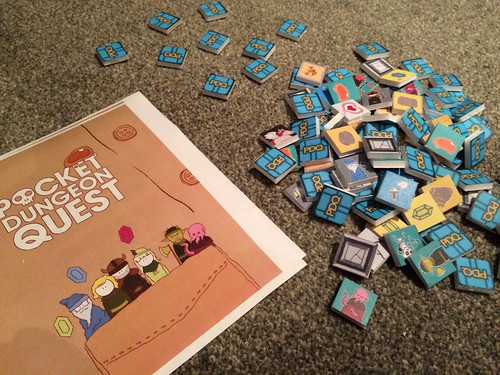
The Game, by Jeff Dehut
Pocket Dungeon Quest (or PDQ) is a short, simple game which should be easily playable with younger children created and designed by Jeff Dehut. It is a collaborative game, but like any dungeon adventure, there is a risk that your hero may die. The game has recently finished on Kickstarter, where I backed the Print & Play (PnP) version for $5 as the shipping to the UK was somewhat eye-watering. You can buy the PnP for slightly more ($8) on Gumroad here (https://gumroad.com/l/PDQgame). It took about 30 minutes to mount the game on 5mm foam board using 3M Spray Mount and cut it out. The artwork in the game has a gorgeous playful cartoon style, giving it real character and making it far more child-friendly.
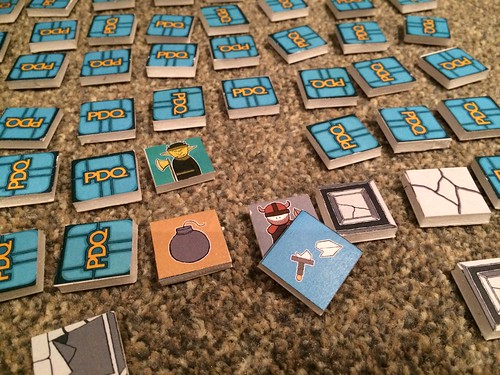
Starting a fight
The PnP has four different characters that you can play - the Warrior, the Rogue, the Archer and the Wizard. The Kickstarter had an extra Hero (‘the Adventurer’, an Indiana Jones style character) which won’t be available anywhere else, not even on the PnP file for backers. Each Hero has a special feature; the Warrior does more damage; the Rogue can steal items and use them before fighting a monster; the Archer can re-roll their attack and the Wizard can use two spells or items per turn rather than one.
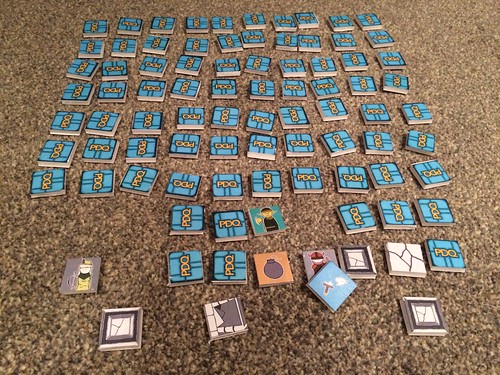
It’s bigger than it looks!
The core of the game is a 10 x 10 matrix of tiles which represent the contents of the dungeon that you are exploring. The tiles include walls (blocking movement), floors (no real effect), spike traps (doing a point of damage), monsters of various types, the dungeon boss, items, spells, bonus/penalty effects for combat, the Pegasus (flies over walls), gems, the Merchant, and three Relics.
The Heroes all start at the edge of the matrix and the turns are very simple. Move, turn over the tiles that you can see (effectively all the unturned tiles adjacent to you). If a monster (or monsters) are revealed, you must fight them before you can grab any loot (items, gems, spells and so forth). Combat is made with a modified d6 with the following results.
1. Red Skull - critical miss, you lose a health point and suffer an additional effect based upon the monster you are facing.
2. Yellow flash - you lose 1 health.
3. Yellow flash (again)
4. 1 Sword - this doesn’t kill the monster, but you don’t lose health. If you’re a warrior then you get an extra sword so this will be a kill.
5. 2 Swords - kills any monster with a direct hit. Can be reduced by a broken sword effect back down to 1 sword.
6. 3 Swords - kills any monster, even with a broken sword.
It’s fast and brutal.
Assuming you kill the monsters, you can take an item from those that you have revealed, and all the others go face down into a discard pile (separate from the discarded monsters). When you turn over the Merchant’s tile, you can exchange 30 gems to buy tile (item or spell) back from this pile. Two tiles are turned over and you choose one of them.
A bad thing is when you reveal the boss. At that point, the party rolls to see how many henchmen he has. These are drawn from the monster discard pile or by revealing tiles on the dungeon if there are not enough monsters discarded. You have to fight your way to the boss through the henchmen to kill him. If the party is down on health then this can be pretty nasty.
There are three different sets of victory conditions defined, each increasingly harder to achieve:
1. Find all 3 relics and exit the Dungeon in one piece.
2. Kill the boss and escape the Dungeon alive.
3. Clear the floor, revealing all tiles and killing all the monsters.
Before I tried this with Nathan, I had two quick tester games. In the first game, I had two Heroes in play, and found the Boss very early after some poor rolls in the first few turns. The four henchmen that he came with were too much much for the poor Heroes who had already been injured and had very little in the way of items or spells. They managed to kill three of them before they all died.
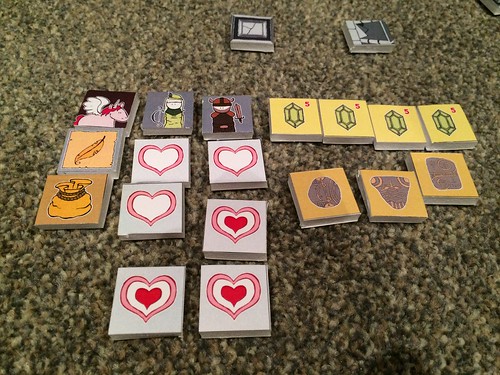
The surviving Heroes at the end of the second game.
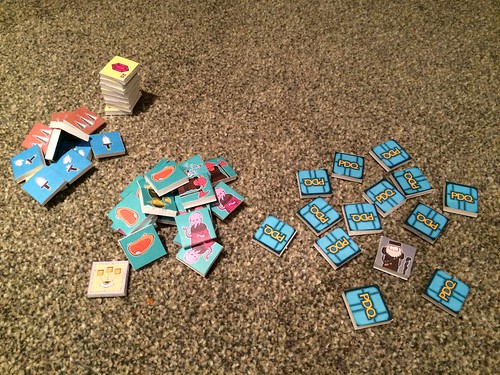
From left to right: traps, sword effects, gems; pile of dead and escapees; Merchant and his wares.
In the second game, the one of the two heroes (a Rogue) died on the first turn when she[1] turned over three tiles including a Minotaur that did 2 health damage on a critical miss. Ouch. She couldn’t heal herself in the combat (as no-one had a healing potion and the Warrior didn’t find the Phoenix Feather spell to resurrect her) and so was gone. I decided to immediate start a third character. As the threats in the game are the same no matter how many players are involved, it may be work allowing the players to have all four heroes in use even if there are only two or three players involved. That, or alternatively boost the health of the characters in play with the spare counters.
[1]: The Hero counters have male and female sides, no game effect and I just picked them up randomly, so ‘she’.
The next game was with Nathan (7) and Aidan (3). Aidan was mainly doing what his brother told him, and was the Warrior. Nathan was a Wizard and I was the Rogue. We had a fun game, playing for the basic ‘find the three relics and escape’ objective. We ended up turning over most of the tiles but fortunately not the boss. I had opted to split the unused Archer’s health between the three of us, and that was good, because we were down to a single health point several times (i.e. dead if we’d played as designed - but we did have a Phoenix feather). Nathan got the idea quickly, and Aidan was happy just playing along and doing what his big brother suggested. We prevailed, just, and they had big smiles on at the end.
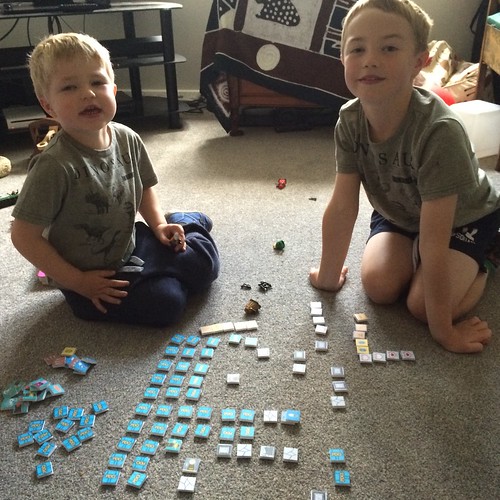
Still smiling!
Nathan (7):
“Brilliant. It was really really good and adventurous. We got to kill all the monsters. We didn’t get to the Boss, but I almost was in with the Boss and I would have died if I had. I’d play it again, a million times if I had time.”
Aidan (3):
“It was good. I enjoyed it. I was the Warrior. I didn’t nearly die like my brother”
In conclusion - a fun, quick, cooperative game that understands the essence of the Dungeon crawl and is easily accessible to kids and adults alike. Recommended.
31 August 2014
#RPGaDay - 31 - Favourite RPG of all time

I’m sure you’ve all guessed this already, even if you don’t know me that well. My favourite RPG of all time is… drum roll… Traveller.
I have loved this game in all its incarnations from that first set of Starter Edition which I finally managed to get hold of after several attempts of ordering and reordering using the old Games Workshop credit note system.
Okay, I’m lying here. I didn’t really love GURPS Traveller, although some of the source material was superb and amongst the best ever written for the game (Interstellar Wars, Rim of Fire, Far Trader, First In, Ground Forces, Starports and Sword Worlds are all excellent).
I also wasn’t partial to Traveller: The New Era, GDW’s reboot, mainly as I didn’t like the core game engine, and I was upset about the violence that the Virus did to the setting. However, I’m much more sanguine about that now as I can see that Virus was just described badly - the mistake was made to use technology descriptions from the 1990s. The pain and sadness of the obliteration of the Imperium have gone now, and in many ways I like the way forward it gave. The 1248 extension to the setting was truly epic and had far too much compressed into too short a time. There were too many collapses and recoveries and major wars to be credible, especially when the limitations of travel time by jump were added to the mix. Had it been 1448 then I’d have seen it as far more believable.
Traveller T20. Well, again this had some good material (the Gateway supplement was an excellent expansion of work done for MegaTraveller) but the Dungeons & Dragons engine being used for Traveller just left me cold.
But I have loved deeply Classic Traveller, MegaTraveller, Marc Miller’s Traveller (T4) and Mongoose Traveller. Traveller T5 isn’t on this list yet as I need to read it fully yet. Across these games the system remains recognisable and the settings remain true.
What makes Traveller stand out to me?
- Character generation that gives you a history (and could kill or maim you in early editions).
- Starship and Star System design sequences that just encourage you to play with them and create vessels and worlds to adventure in.
- The trade rules that mean you can be more than mercenary thugs looking for the next ticket or bank-job.
- A d6 based mechanic with a task engine integrated to handle different difficulties (this was revolutionary with it was introduced). Ideally this is 2d6 based, but the T4 and T5 Nd6 engine also works well. I know, I ran it a lot.
- The jump technology that means communications are limited to the speed of travel between stars.
- A system of Tech(nology) Levels that define the capability of cultures.
- Limited Psionics, with an SF feel.
- And the setting.
It is fair to say that the setting in Traveller reflects the time that it was released (1977). The Third Imperium feels very like 60s and 70s harder SF. The tropes are there from Andre Norton, Isaac Azimov, E.C. Dumarest, Sir. Arthur C. Clarke, Robert Heinlein and many, many more. This is only natural, and the influence of Star Wars (which came out at the same time) can also be seen. As the different waves of style have washed through SF, Traveller has adjusted ever so slightly. The setting has cultural memes that explain why cyborg-style upgrades and AI are frowned upon. Nanotechnology is far beyond the Tech Level of the Third Imperium. And computer tech is more in keeping with the old ‘Big Iron’ that was seen in the 1970s and earlier[1]. This is not out-and-out Transhumanism, with the huge reaches of scale that can imply. You want a different game for that.
However, because the feel of society is similar to ours, because it is so recognisable, it makes the stories of the characters so much more believable. I play to the harder SF end of Traveller, whereas other run out-and-out Space Opera. There’s room for both in the Third Imperium and the game system is content with either.
Over the last 30 years, Traveller has given me much joy. I hope that in some little ways the work that I’ve done with BITS (http://www.bitsuk.net/) and the scenarios I’ve run and written have passed that back to others. Marc Miller, Loren Wiseman and the rest of the team from GDW have huge thanks from me for creating this game which has endured. Andy Lilly also deserves my thanks for letting me get involved in BITS.
And if you haven’t tried Traveller, coming up very soon is the Traveller: Lift Off starter set Kickstarter, or you can dive in with Mongoose Traveller, or pick up the entire back catalogue electronically via DriveThruRPG (http://rpg.drivethrustuff.com/browse.php…) or on CD via FarFuture Enterprises (http://www.farfuture.net) (the best way if you want a lot of the books). FFE also stock the Traveller T5 book.
[1]: Although personally I have never found an issue using more advanced tech like we see today and avoiding violence to the setting’s integrity.
[2] A note on the picture - I couldn't find my copy of TNE (I think it's in the eBay pile) nor my paperback T4 (well worn and stashed on a shelf somewhere) and I sold T20 a long time ago...
30 August 2014
#RPGaDay - 30 - Rarest RPG Owned


So, for example, if you own the original BITS printing of *The Long Way Home* for *Traveller*, and you have an unsigned copy, then you have a truly rare book as most of the hundred or so copies were signed (in return for a donation to charity). Mine is signed, so not quite so rare. BITS is a very small press publisher compared to most of the rest of the market.
If you look at books from the majors, I have *Ringworld* and its companion volume, Chaosium’s d100 BRP take on Larry Niven’s epic SF setting. This was rare, possibly due to the cost that it was when it was initially for sale. It also was discontinued pretty quickly.
I also have a copy of the Last Unicorn Games *Dune* RPG. This is a lovely setting book (the system less so) which sets the action before the Frank Herbert novels (kind of the way way that Brian Herbert and Kevin J. Anderson have done but not at all awfully). The entire initial print run sold out quickly, as LUG was acquired by Wizards of the Coast (who had planned a d20 Dune version), but then the licence was pulled by the Herbert family. I keep on flirting with selling this as as sometimes it goes for a small fortune, but haven’t quite got that far.
The thing is, in these days of eBooks and print-on-demand, it is hard for a book to go out of print unless it is a licensed article. Even if a publisher shuts down actively, they may as well leave the book on Drive Thru RPG as a revenue earner as it costs them nothing. Thus, a rare book must be out of print and not available electronically.
Ultimately, I think I will pick *The Lost Supplements* for Classic *Traveller*. Those of you who like classic SFRPGs will remember the Keith Brothers. They were prolific in the early days of the hobby. J.Andrew Keith[1] had produced a whole set of books which became obsolete as the line transitioned to MegaTraveller. John Paul Sanders founded Cargonaut Press[2] (now defunct) to (initially) publish the first of these lost volumes, a book on Piracy in the Imperium called *Letter of Marque*. These were soon expanded to a bigger collection[3] of all the unpublished works called *The Lost Supplements Collection*. The material dripped ideas and captured the feel of the Classic (Golden) Era of *Traveller* perfectly.
[1]: http://wiki.travellerrpg.com/J._Andrew_Keith "J. Andrew Keith Bibliography"
[2]: http://wiki.travellerrpg.com/Cargonaut_Press "Cargonaut Press"
[3]: http://wiki.travellerrpg.com/Lost_Supplements_Collection "Summary of the Collection."
29 August 2014
#RPGaDay - 29 - Most memorable encounter
I found this one incredibly hard, for three reasons. Firstly, I usually end up being the one running the games. Secondly, I don’t actually get to play - or run - that often. Finally, my memory is not so good as it used to be, probably related to the reduced amount of decent sleep I get these days.
I’ve used three examples already; the ballistic bowshot in the *RuneQuest 3 Glorantha* game, the monster that wouldn’t die in the *AD&D 2nd Edition* game with my old Paladin character, and the Werewolves through the Walls incident I mentioned in yesterday’s piece.
So, here is my shortlist:
1. I played in a BITS *Traveller* game quite some time ago (not sure if this was at a *TravCon* or a *GenCon UK*, along with my friend Derrick, and run by Andy. The game - if I remember - was called ‘Family Business’ and from my recollection, it involved a hostage situation. Anyway, it all got a bit out of hand when we wanted to get some information out of a non-player character. I think Derrick managed to completely shock the Referee. We needed information urgently out of a bad guy, and decided to intimidate it out of him. In fact, that was the only skill that we had that was any use.
So Derrick came up with a plan. He had my character drag out the victim tied up. We threatened him, and got told “I’m not going to talk”. So he was blindfolded and dropped on the muddy floor. Del’s character had mine get the spare tyre off the Land Rover analogue that the victim had seen already. The engine was stared, and then Del’s character used the spare tyre and someone revving the engine to pretend his character intended to drive over the person being interrogated. The guy spilled (and Andy was shocked at the approach), and he was returned to his cell blindfolded so he never knew it was a bluff.
2. Technically, the next one wasn’t so much an encounter as an extended set of small encounters. We were playing at the Chester RPG club, playing AD&D 2nd Edition in Jac W’s game. As a party, we were based in a port city and desperate to track down a contact who suspected in a theft. We think he had left the town in a certain ship, so yes, we spent the entire session chasing around town searching for a ship called “The Scarlet Herring”. Oh how the GM laughed when realisation dawned! And how we cringed…
3. Recently, I had great fun in Timothy C’s *Traveller* game at *TravCon 14* where I was playing a very stressed ship’s captain whose crew managed to keep on finding stow-aways. I ended up channelling a combination of Basil Fawlty and the stresses at work I’d been under as the Captain had a meltdown about the incompetents that worked for her. I nearly lost it in giggles towards the end. The other players seemed to enjoy it too. A combination of black humour and management-speak. I think that the scenario was called ‘Three Blind Mice’ and published by a German company.
And the winner?
It has to be the *Beat to Quarters* game I played one Saturday night at Furnace, run by Neil G and including other players such as Michael Reddick. Neil had decided to run a game based loosely on the lyrics of *The Irish Rover*, and he decided (and probably regretted) asking for us to give a number of ‘suggestions’ for plot elements. These included - if I remember correctly - the Holy Grail and possibly Moby Dick. The game sparked, flew around manically and the player all riffed off each other. The encounters are all blurred together now, but it was a truly marvellous game. Neil seemed to be like a rabbit stuck in headlights, trapped between laughter and horror at what we had done to his scenario and game. At the end, he banned us from playing again.
I’ve used three examples already; the ballistic bowshot in the *RuneQuest 3 Glorantha* game, the monster that wouldn’t die in the *AD&D 2nd Edition* game with my old Paladin character, and the Werewolves through the Walls incident I mentioned in yesterday’s piece.
So, here is my shortlist:
1. I played in a BITS *Traveller* game quite some time ago (not sure if this was at a *TravCon* or a *GenCon UK*, along with my friend Derrick, and run by Andy. The game - if I remember - was called ‘Family Business’ and from my recollection, it involved a hostage situation. Anyway, it all got a bit out of hand when we wanted to get some information out of a non-player character. I think Derrick managed to completely shock the Referee. We needed information urgently out of a bad guy, and decided to intimidate it out of him. In fact, that was the only skill that we had that was any use.
So Derrick came up with a plan. He had my character drag out the victim tied up. We threatened him, and got told “I’m not going to talk”. So he was blindfolded and dropped on the muddy floor. Del’s character had mine get the spare tyre off the Land Rover analogue that the victim had seen already. The engine was stared, and then Del’s character used the spare tyre and someone revving the engine to pretend his character intended to drive over the person being interrogated. The guy spilled (and Andy was shocked at the approach), and he was returned to his cell blindfolded so he never knew it was a bluff.
2. Technically, the next one wasn’t so much an encounter as an extended set of small encounters. We were playing at the Chester RPG club, playing AD&D 2nd Edition in Jac W’s game. As a party, we were based in a port city and desperate to track down a contact who suspected in a theft. We think he had left the town in a certain ship, so yes, we spent the entire session chasing around town searching for a ship called “The Scarlet Herring”. Oh how the GM laughed when realisation dawned! And how we cringed…
3. Recently, I had great fun in Timothy C’s *Traveller* game at *TravCon 14* where I was playing a very stressed ship’s captain whose crew managed to keep on finding stow-aways. I ended up channelling a combination of Basil Fawlty and the stresses at work I’d been under as the Captain had a meltdown about the incompetents that worked for her. I nearly lost it in giggles towards the end. The other players seemed to enjoy it too. A combination of black humour and management-speak. I think that the scenario was called ‘Three Blind Mice’ and published by a German company.
And the winner?
It has to be the *Beat to Quarters* game I played one Saturday night at Furnace, run by Neil G and including other players such as Michael Reddick. Neil had decided to run a game based loosely on the lyrics of *The Irish Rover*, and he decided (and probably regretted) asking for us to give a number of ‘suggestions’ for plot elements. These included - if I remember correctly - the Holy Grail and possibly Moby Dick. The game sparked, flew around manically and the player all riffed off each other. The encounters are all blurred together now, but it was a truly marvellous game. Neil seemed to be like a rabbit stuck in headlights, trapped between laughter and horror at what we had done to his scenario and game. At the end, he banned us from playing again.
28 August 2014
#RPGaDay - 28 - Scariest Game you’ve played
The scariest game that I have played happened back when I was still in secondary school. One of the things that we did several times was to take part in a 24 hour sponsored role-playing event for charity. We did this at school and I think that we also did this at my home. I think that my parents went out for the evening, but I may be wrong. I’m sure it was at my house, but again, memories have faded a bit.
Now, I know that this happened sometime between being aged 16 (when we moved out to a small village in South Cheshire from Holmes Chapel) and before my year out for University when I was 19. It was either a 24 hour event or some friends were staying over.
We where playing AD&D, probably second edition, and I’m pretty certain that John N was running the game. It was pretty dark fantasy (this was around the time the first Ravenloft boxed set was released) and I can remember us staying in an Inn in a village that had been beset by a monster. In this case at least one Werewolf. Our characters had hired a suite of rooms, and we’d locked the doors (which were sturdy)and put furniture behind them. Classic horror story siege mentality. The atmosphere was amped up by playing with a single light (I can’t remember if it was a candle) and the rest of the house being quiet and dark during the night.
We heard the Werewolf enter the building, there were screams and then we heard snuffling outside our door. Gripping our weapons (we all were lowish level and in a meta-gaming sense knew we needed silver weapons) and keeping very quiet, the tension built up. The door was tried. The lock clicked. The furniture stopped it opening. Then everything went quiet. And then the Werewolves (for there were more than one of them) burst through the walls rather than the door and completely freaked us out. Chaos ensued. Someone’s character jumped out of the window risking death rather than be torn apart.
Anyway, I can’t remember whether we survived or not. Or what else happened. But what sticks with me is that we all felt it necessary to go to the toilet when the game had a break in at least pairs, as no-one fancied walking out into the darkened house on their own…
Now, I know that this happened sometime between being aged 16 (when we moved out to a small village in South Cheshire from Holmes Chapel) and before my year out for University when I was 19. It was either a 24 hour event or some friends were staying over.
We where playing AD&D, probably second edition, and I’m pretty certain that John N was running the game. It was pretty dark fantasy (this was around the time the first Ravenloft boxed set was released) and I can remember us staying in an Inn in a village that had been beset by a monster. In this case at least one Werewolf. Our characters had hired a suite of rooms, and we’d locked the doors (which were sturdy)and put furniture behind them. Classic horror story siege mentality. The atmosphere was amped up by playing with a single light (I can’t remember if it was a candle) and the rest of the house being quiet and dark during the night.
We heard the Werewolf enter the building, there were screams and then we heard snuffling outside our door. Gripping our weapons (we all were lowish level and in a meta-gaming sense knew we needed silver weapons) and keeping very quiet, the tension built up. The door was tried. The lock clicked. The furniture stopped it opening. Then everything went quiet. And then the Werewolves (for there were more than one of them) burst through the walls rather than the door and completely freaked us out. Chaos ensued. Someone’s character jumped out of the window risking death rather than be torn apart.
Anyway, I can’t remember whether we survived or not. Or what else happened. But what sticks with me is that we all felt it necessary to go to the toilet when the game had a break in at least pairs, as no-one fancied walking out into the darkened house on their own…
27 August 2014
#RPGaDay - 27 - Game You’d like to see a new / improved edition of…

A more consistent and well edited version of Mongoose *Traveller* is probably too much of an ask based on past experience with the publisher, but it would be a good thing. The expansions have not been coherently done with huge numbers of skills and mechanics added in. So, that aside, what would I love to see a new edition of?
I was disappointed with the new edition of *The EsoTerrorists* which came out recently. The content was good, but a very small font size had been used and it was softcover, unlike pretty much all the rest of the GUMSHOE range which are lovely hardbacks. I would happily pay for the same content again, but done across say 200 pages rather than 160 and in hard cover. But that’s pretty simple for Pelgrane to do, so let's look somewhere else.
*Blue Planet* springs to mind. The 2nd edition was brilliant and - had I still owned it - may have even made the list of game that I want to play that no-one else does from two days ago. If you don’t know the setting, then you’ve missed out on a treat. Humanity has spread to a new world - Poseidon - at the end of a wormhole found at the edge of the solar system. The environment on Earth is fragile after years of abuse. Players are colonists in a new world of opportunity and adventure, a world with superb, detailed, background. In many ways, it was the opposite of *Traveller*. Rather than the whole of the universe to explore, you had one world. And it felt as big as the universe. There was also a plan to release a supplement (or even partner RPG) called *World of Hurt*. This was going to give a very *Blade Runner* style setting back on Earth, but this never happened.
Anyway, I know what I want. I want a version of *Blue Planet* built with the Mongoose *Traveller* engine. I want it as a distinct line with tight quality control, and I want it now!
(Okay, so I realise that I could hack 2300AD to do this reasonably easily, but I'd rather someone else did it for me!)
26 August 2014
#RPGaDay - 26 - Coolest Character Sheet

‘Coolest character sheet’ as a category really seems to be scraping the barrel!
1. Character sheets should be simple.
2. Character sheets should be clear.
3. Character sheets should have enough space for players to make mistakes and to write easily.
4. Pretty character sheets are often missing the point.
I think that the old index card approach of a very simple character sheet used by *Traveller* was excellent. I love the concept of 100 words about your character pioneered by *Hero Wars* (easily replicated in *Wordplay* as well).
If you play in a convention game, the balance there needs to be between clarity and atmosphere. In my case, I more often focus upon clarity. The only time I haven’t was with the *Savage Worlds* conversion of *2300AD*’s *Mission Arcturus*, which I’ll post as examples. I am still quite proud of those.
25 August 2014
#RPGaDay - 25 - Favourite RPG no one else wants to play
This one really isn’t a problem for me, as I don’t have a regular gaming group, so there’s no-one saying “no” to anything.
24 August 2014
#RPGaDay - 24 - Most Complicated RPG Owned

Sometimes, the complexity isn’t in the mechanic. It’s in the style or method of play when it moves away from your comfort zone. For example, the narrative engine used in *Hero Wars* was very different to many traditional RPGs when it was first released and it was only after playing it that I really got my head around it. It wasn’t really difficult, rather it was a mindset change.
The *Maelstrom* RPG (again, not the Elizabethan game from Arion) performed a similar mental jump. It moved to a scene based resolution system, presaging the conflict/contest resolution engines which have become more popular with the indie games.
Games like *Durance*, *Kingdom* and *Fiasco* added a discover-through-play approach which can also be very complicated and disconcerting for people used to more traditional RPGs.
Games like *Dungeon World* shift the whole mechanic of rolling dice to the GM who essentially reacts to the players actions with sets of guided moves in a different approach to more traditional games.
All these are complicated until you get to know them.
If you look for traditionally complicated, then I could mention *Traveller* or *AD&D 2nd Edition*. AD&D for the fact that the system does not truly mesh and flow easily (although it works), and Traveller for the fact that although the core mechanic is simple, if you move into ship design, star system or alien design it becomes more and more complicated.
In fact, I think I will plump for *Traveller 5* as my most complicated game, as it weighs six pounds, and it contains every supplement and expansion that you’d ever need for the game system in its 654 pages. In truth, it is really simply laid out and very easy to follow, but Marc 's masterpiece is intimidating to look at, and a casual flick would make you think it was scarily complicated. At its essence, it is really simple to play, but the wheels that underly and build the universe are impressive in their scale.
23 August 2014
#RPGaDay - 23 - Coolest looking RPG product / book
First of all, a call out for the cover of a game that gives me shivers of anticipation every time I see it. That’s the new, blue, cover of *Wordplay*. Designed by Stephanie McAlea, this is an absolutely beautiful piece of design. However, I’m ruling this out as I was closely involved in commissioning and approving it. Absolutely gorgeous though, and you’ll see more of its ilk when we finally get the *Utopia* sourcebook out too.

Honourable mentions go to the following games:
1. *Conspiracy of Shadows*, which has an evocative red cover with a symbol that could be an eye on it. Whatever it is, it kept drawing me back until I bought it.
2. *Dead of Night*, Andrew Kendrick’s horror RPG. This screams out horror and delivers on what it promises. Captures the genre very well.
3. *Tremulus* RPG. Sean Preston’s Apocalypse-World engined Lovecraftian horror game. Stark, simply designed and (in the hardcover) with a matt cover that is strangely soft to the touch.
4. *Saga of the Icelanders* RPG. Another Apocalypse-World engined game, this time set in Icelandic history. The landscape format is novel, and the images and faces used on the cover make it feel grounded in history and myth.

My runner up has one of the most simple and stark images used in a game for a long time, a style that was carried across the whole line very successfully. This is Contested Ground Studios’ *A|State* RPG. Very different in presentation to its competitors. This just topped their *Cold City* RPG for this position, another simple and visually effective cover.
1. *Conspiracy of Shadows*, which has an evocative red cover with a symbol that could be an eye on it. Whatever it is, it kept drawing me back until I bought it.
2. *Dead of Night*, Andrew Kendrick’s horror RPG. This screams out horror and delivers on what it promises. Captures the genre very well.
3. *Tremulus* RPG. Sean Preston’s Apocalypse-World engined Lovecraftian horror game. Stark, simply designed and (in the hardcover) with a matt cover that is strangely soft to the touch.
4. *Saga of the Icelanders* RPG. Another Apocalypse-World engined game, this time set in Icelandic history. The landscape format is novel, and the images and faces used on the cover make it feel grounded in history and myth.

My runner up has one of the most simple and stark images used in a game for a long time, a style that was carried across the whole line very successfully. This is Contested Ground Studios’ *A|State* RPG. Very different in presentation to its competitors. This just topped their *Cold City* RPG for this position, another simple and visually effective cover.

My winner? It’s another from Contested Ground. *Hot War*. Set in London, during the winter of 1963, post apocalypse from atomic and occult warfare. It combines photographs with design and typography that grabs my attention really strongly. Both cover sets - the one used for the normal softcover and for the hardcover limited edition - are superb. The game is excellent too; dark, and supporting of a variety of play styles. It is one of my favourite games and deserves the title of ‘coolest game’.
22 August 2014
#RPGaDay - 22. Best Secondhand RPG Purchase
Over thirty years in gaming has meant that there are lots of candidates for today’s entry, split mainly between games acquired at conventions (and I think that I mentioned 'The Flaming Eye' and 'Wordbuilder’s Handbook' earlier), games bought in the late 1990s at Best Books & Games in Liverpool, 'Traveller' material bought through BITS old auctions when I was filling out my collection, and then eBay and other sales site (especially when I was after 'Pendragon' books).
My most strenuous searches were from some of the material produced by 'Pagan Publishing' for Call of Cthulhu. I hunted high and low for the old 'Delta Green Chapbooks' at a sensible price, ultimately unsuccessfully, but in the end backed the Fundable campaign (an earlier take on Kickstarter and Indie-go-go that failed.) for the collected hardcover versions. I also looked hard (and found) their scenario and campaign books such as 'The Realm of Shadows', 'Mortal Coils' and 'Coming Full Circle' but there was one that always escaped me. I’d lose bidding wars on eBay, and never found it in shops. The few conventions that had it were asking silly prices.
Anyway, recently Angus was clearing some of his old games, and I finally managed to get myself a copy of 'Walker in the Wastes'. It hasn’t made it into an archive cover yet, not has it been read (but it’s sitting in the ‘to-read’ pile), but I hope that it likes up to the anticipation of a decade long hunt!
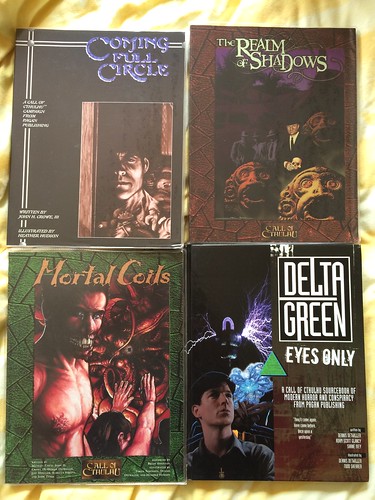
21 August 2014
#RPGaDay - 21. Favourite Licensed RPG
I choose 'The One Ring', by Cubicle 7. It triumphs over Chaosium’s 'Elric!' (reprinted and expanded as 'Stormbringer 5th Edition'), but only just.
'Elric!' is a game that I spent a huge amount of time playing being the fourth iteration of the 'Stormbringer RPG' that had won my heart for its chaotic, power gaming, devil-may-care embrace of Michael Moorcock’s 'Eternal Champion' sequence. I still hold the game engine as one of the best iterations of the BRP d100 system, and some of the supplements were superb (for example the third party 'Corum' book). I spent several Continuum/Convulsions as Loz’s only friend at the Eternal Champion seminar (I exaggerate a bit). I ran an extended campaign with a number of people here on Facebook for some years - Derrick, Duncan, Andrew, Charles, Sarah-Jo to name a few and it was great fun. Two things eventually broke it for me. Firstly, time. One of the scenarios (‘The Fang and the Fountain’ from 'Perils of the Young Kingdoms') had a brutal, power-wielding, conclusion which was truely epic. But the battle took 7 hours. When you get maybe 8 hours of gaming every two months with a group, this took too long. I thought I’d found a solution when I accidentally managed to write a 23,000 word conversion of the game to 'HeroQuest', which was going to be published as a Continuum con book, but then the rights moved to Mongoose and I lost heart. The campaign ended with a whimper… Recently, I’ve started playing with a house 'Wordplay' port, and my old material may appear again. Maybe.
Anyway, 'The One Ring'. Quite simply, this nails the feel of Tolkien’s 'The Lord of the Rings' and 'The Hobbit' and puts you in a position where you can run a campaign without fear of the epic story intimidating or trampling over you. It is evocative, and the system quite simple. The default setting is between 'The Hobbit' and LotR around Mirkwood, and the writing is gorgeous. I mentioned 'Rivendell' back in the 4th entry. The standard of that book resulted in me re-reading the Core Rules (revised), 'The Heart of the Wild', 'Tales from Wildland', 'The Laketown Guide' and 'Words of the Wise'. I only didn’t re-read the superlative 'The Darkening of Mirkwood' because I only just read it only and it was still fresh. I rarely binge on RPG systems like this, and it really gives me an itch to run or play it. Simply superb.
20 August 2014
#RPGaDay - 20. Will still play in 20 years tim
Almost certainly 'Traveller'. Mind, I’ll be in my sixties and may be looking for that gaming retirement home.
I love SF, always have. 'Traveller' epitomises that for me and is meshed to the books that I grew up loving after I discovered Andre Norton at my local library, and then E.E. ‘Doc’ Smith, Arthur C Clarke (not ‘Sir’ then) and Isaac Azimov on my father’s bookshelves.
Incidentally, if you love SF, then I commend Jo Walton’s 'Among Others' to you as a novel that will remind you of how you discovered the genre.
19 August 2014
#RPGaDay - 19. Favourite Published Adventure
Now this is a hard one, as there have been so many memorable adventures out there… I’m going to limit this to something that I’ve run, rather than just read or played, as that cuts the field down somewhat.
I’ve always had a soft spot for 'Masks of Nyarlathotep' for 'Call of Cthulhu'. I bought it second hand when I lived back in Holmes Chapel from a group of gamers over there and started to run it twice. It is a great epic adventure in the horror genre, but very messy in terms of character mortality. It’s possibly only challenged by the recent Pelgrane Press release 'Eternal Lies', or maybe Chaosium’s 'Beyond the Mountains of Madness' (although that needs a certain mindset). As a GM you need to make sure that the players have ‘corresponding’ friends so that they have an easy excuse to introduce new characters. In both the campaigns attempts I made to run this, the original party had all passed away or gone non-functionally insane by the time that they reached. As a result, I don’t think that this makes the cut.
What else? Well, 'I6 - Ravenloft' for 'Advanced Dungeons & Dragons 1st Edition' was a very different classic adventure. Dark horror with a very dangerous enemy. It had all the classic horror tropes, and actually makes players with high powered characters scared for their survival. Great scenario, but I’ve not touched it for a long time so not that.
One of my favourite scenarios ever was 'Phantom of the Northern Marches' for 'Middle Earth Role Playing (MERP)'. It was so evocative and epic, and really reflected the lower power sad beauty and feeling of the northern realms of the Dunedain as they slowly crumbled before the power of the Witch King of Angmar. This was a non-epic scenario that made the players have a chance to feel completely heroic. Lovely setting, lovely writing, lovely scenario. But not my favourite.
If I had allowed scenarios that I hadn’t run, then the 'MegaTraveller' supplement 'Hard Times' would be a strong contender. This puts the players in the position of ‘keeping the flame’ as the Imperium collapses during the Second Civil War under infighting and factionalism. The characters have a ship and can make a difference to a small number of worlds. Absolutely brilliant writing and a great campaign; incidentally, it’s one of the reasons that I really didn’t like Virus with Traveller: The New Era was released as it wiped all these efforts out. But I’ve not run it, so it’s not in the running.
I think that I will go for a campaign pack that has given me hours of fun as a GM, is broad enough that you can do pretty much anything with it, and was really the first book to give my favourite RPG the true flavour of it’s setting. I am talking of the Classic 'Traveller' Adventure 'Adventure 3 - Twilight’s Peak'. This is a campaign framework for a group of players to take a starship that has seen better days along the Spinward Main, ostensibly to earn enough cash to properly refit it. But they also get a great big hint about lost treasure which could make their fortune. They may, or may not, stumble upon this. I’ve run it twice and one party found it, the other didn’t. But it doesn’t matter; you soon come to the realisation that the journey – the Travelling - is actually the most important thing. This is still usable with the current versions of 'Traveller', and if you get the Classic 'Traveller' DVD [from Marc Miller] then you are set for hours of fun as that has all the other published adventures to mesh around it too.
18 August 2014
#RPGaDay - 18. Favourite Game System
I find this quite an interesting question, as sometimes the system is fundamentally meshed with the setting. However, if I had to pick one game system as a favourite, it would be 'Wordplay'. Developed by Graham S and the group of Sheffield gamers which I used to play with regularly, this is a game dear to my heart. I spent a lot of time involved in play testing and also in helping to develop parts of the system. I also proofed and laid out the game for publication.
At its heart, 'Wordplay' requires you to build a hand of ordinary common-a-garden six sided dice. You throw these, and each 6 gains you two successes, each 4 or 5 gives one success, and 1-3 gives you nothing. You then compare the difference in levels between an opponent or a fixed difficulty, and the wider the gap, the bigger the success level. In many ways, 'FATE' works in a similar way, but that wasn’t an inspiration for the game engine.
You build the hand through taking a trait (which is rated in numbers of dice that go into a dice pool) and then potentially picking up to two supporting traits (which add a reduced number of dice based on their original levels). Other players can help by lending you a helping dice from their character. You can also gain dice from equipment and the environment. You can create temporary traits through narration or action that can also help.
Nothing ever takes dice away from you; you can only ever gain dice. Even if you are wounded, you do not lose dice. Say you had 'Broken Arm (3d)' and that trait would act against you in a task, then you would give your opponent 3 extra dice. One of the sweet things in the system is that you can see who helped or hindered you.
Final task resolution effectiveness can be gauged from a table - in all cases, a 7 success margin is a total victory.
'Wordplay' sits firmly on the fence between contest resolution and task resolution. You can use the system in either way; either frame the outcome you want to achieve, or approach it like a traditional RPG and roll with the dice at a more granular level. You can resolve with a single roll, or have an extended contest. The use of descriptive traits makes it really easy to build characters and adventures. The dice mechanic is quite clever, as it engages gamer instincts in building a hand of dice, but the process is quite swift. The outcome supports narrative resolutions, and the whole system hits a sweet spot for me.
'Wordplay' deserves more recognition than it has, and hopefully it will get it soon. Currently, the PDF and POD book sit at [Lulu.com], but the intent is to migrate them to RPGNow/DTRPG in the near future. There are two supplements nearly completed, so hopefully the game will gain in popularity.
So that, ladies and gentlemen, is my favourite game system.
And yes, I also love the bell curve functionality of 'Traveller' and the d100 simplicity of the Basic Role Playing engine which started at Chaosium. But 'Wordplay' is now my go-to system.
17 August 2014
#RPGaDay - 17. Funniest Game you’ve played
Undoubtedly West End Games' ‘Paranoia’. Dark, apocalyptic humour set after an atomic war, where the players are all clones who live in a complex controlled by 'The Computer'. I started playing this with the first edition, but my heart was taken by the revised and simplified second edition that Games Workshop released as a hardback.
I lost touch with this game after school, and I wouldn't mind running or playing it again.
I lost touch with this game after school, and I wouldn't mind running or playing it again.
16 August 2014
#RPGaDay - 16. Game you wish you owned
 |
| Holmes Basic - my entry into D&D |
This one is quite simple. I wish that I still owned the first boxed set of 'Dungeons & Dragons' that I was given as a Christmas Present. I sold it after I moved on to 'AD&D First Edition'. I still have my 'Starter Edition Traveller' and 'Call of Cthulhu 2nd Edition' boxed sets, and would love to have had the other game I got at the start of my gaming.
It's pure nostalgia, but it's that simple.
15 August 2014
#RPGaDay - 15. Favourite Convention Game
I'm going to split this into a number of different categories, starting with my favourite convention game to run. It may surprise you, but it isn't 'Traveller'. Nor is it 'Singularities' or 'Wordplay'. It's a small indie game called 'Conspiracy of Shadows' which - while available - is no longer actively being supported.
The game is set in a dark medieval Eastern European style setting, and could best be described as a 'Medieval X-Files' with lots of guidance on building conspiracies and developing plot arcs for players to interact and investigate. As a game, it drips atmosphere, and the author is also an artist and nails the whole experience.
Now, the reason I love this game to run at conventions is a style of play that it has called 'The Blood Opera'. This is a scenario where all the characters are set up to conflict with with other for different reasons, and effectively the narrator's role is to light the fuse on a powder keg, or to give the row of dominos a push. I've run two versions of this repeatedly at conventions. The first is the classic Blood Opera where a noble family tears itself apart in the snows of winter after the death of a beloved wife. The second is one I built myself called 'The Fall of House Atreides' which does much the same but uses the start of Frank Herbert's classic "Dune" as the scenario. Anyone - including Paul Atreides - can be the traitor. Both of these seem to get a good response from players, although the first tends to develop silly accents which actually tend to add to the fun.
The game I most enjoyed running at a convention recently was a Savage Worlds game in the 'Runepunk' setting. 'Runepunk' is a science-fantasy setting in a metropolis separated from the rest of reality after some kind of incident. The technology is steampunk and clockwork and it has a feel of Stormbringer and Bladerunner placed in a blender. A couple of 'Furnace's ago I decided to run it, using an investigative campaign called 'DarkSummer Nights'.
The game itself was a delight to GM, with players really getting into character (and me as GM having too much fun interacting with Tom Z who was a clockwork automaton). Several of the players were regular 'Call of Cthulhu' players, and engaged the scenario in exactly the same way that you would play that game. The resulted in no combat at all during the adventure (something I never expected with 'Savage Worlds' as it is at heart a skirmish game) and the discovery that the game engine works quite well for general resolution. A great game in a great setting made memorable by some great players.
Games I have played and enjoyed at conventions are a bit of a challenge. First of all, I don't get to play that often. When I do, I often pick games to get an idea of how the should play because I am thinking of them.
So, memorable games include: Graham S running is Middle Earth games. The first one I played used a hack of 'Burning Wheel' (and was set just after the Battle of the Five Armies way before Cubicle 7's TOR written), and the second one used 'Wordplay' (and was set in the First Age during Turin's saga). Both were super games to play in, and Graham's love and understanding of the setting came through clearly.
Next up would be John Ossoway running 'River of Heaven', his d100 engined SF RPG. Playing this was superb, as John and I have a similar taste in SF and the game showcased the system and the feel of the setting to perfection. It's a style of gaming that I would love to do more often.
After that, I have to give @Evil Gaz a shout out. I played a 'Savage Worlds' game of his one 'Continuum' which involved a pulp expedition to Darkest Africa. It was great fun. I remember riffing with @Tom Zunder and others as explorers in a dangerous world.
I have to include the first 'Hero Wars' (aka 'HeroQuest') game I played. This was run by John Hughes, and it helped me to click what the whole HQ engine was about, and the differences in the style of play.
Finally, an honourable mention to Newt - I previously mentioned his 'Unknown Armies' game. This is one of my happy game memories from conventions past.
So - no Traveller here? Probably as I usually run it, and almost never get to play. :-(
14 August 2014
#RPGaDay - 14. Best Convention Purchase
These go back to GenCon UK, back in the day when it was held in Loughborough. One year I came across the old Digest Group modules for MegaTraveller that I didn't already own on a second hand stall. They also weren't priced stupidly; as a result, I scored a copy of The Flaming Eye and World Builder's Handbook for the price of a normal softcover supplement.
Another year, my friend Richard T and I came across a pricing scheme for boardgames that hadn't been thought through. It was something like 10% off one, 20% off two, 30% off three etc. which on three games meant you effectively got one for free. We bought a selection between us and immediately after the trader changed the offer to something less generous. There are times when being numerate helps.
I also have fond memories of buying two copies of the shortlived Dune RPG at list price, one for Duncan and one for myself, which was great as they rapidly went up in price afterwards to the point I wouldn’t have been able to buy a copy.
Another year, my friend Richard T and I came across a pricing scheme for boardgames that hadn't been thought through. It was something like 10% off one, 20% off two, 30% off three etc. which on three games meant you effectively got one for free. We bought a selection between us and immediately after the trader changed the offer to something less generous. There are times when being numerate helps.
I also have fond memories of buying two copies of the shortlived Dune RPG at list price, one for Duncan and one for myself, which was great as they rapidly went up in price afterwards to the point I wouldn’t have been able to buy a copy.
13 August 2014
#RPGaDay - 13. Most Memorable Character Death
This is one that I find a struggle. I've mainly acted as Games Master throughout the time that I've been gaming, and there aren't that many memorable occasions where I've had a character die. It's not something that worries me too much - if it matches the story and feels right, then I'll go with it as it can open up lots of interesting character interaction. Probably the only one that really sticks in mind was during a game of Legend of the Five Rings that Richard M was running, where my Crab Clan Warrior ended up in some kind of honour duel (I think) which he won, but immediately had to commit suicide to maintain clan honour. I've only vague memories of this, but do remember that I did get a decent replacement.
I've seen some other memorable character deaths; probably the most significant was Greg L’s character 'Art' during a Traveller campaign that I ran back when I lived near Chester. This was a blend of Twilight's Peak, a bunch of other Traveller scenarios and a bit of CJ Cherryh's Merchanters and Andre Norton's Free Traders. It was a game of restaurants, docksides, and side missions, with a very mixed and dysfunctional crew. If anything, the party ended up more nervous of dockside interactions because "bad things happen in bars and restaurants", usually driven by the players. Art died off camera, and the repercussions shattered the campaign. Alli M’s Aslan stalked off, and Steve H’s character 'Kira' was left holding the baby. Probably the best write up of this was done by Steve, and he kindly lets me host it on my site.
The other kind of memorable character deaths that spring to mind tend to have been when I have run Traveller convention adventures. These have included the character group that decided to risk breaking into a starport when sighted by a starship scale laser defence battery, ignoring the warning shot. As they were in an Air/Truck, basically a flying Transit van, this wasn't especially smart. Another included the last surviving crew member of a ship which had been swallowed into a corsair, who rather than surrender and be murdered, opened up inside the corsair with the ship's lasers, scoring critical hits until the reactor exploded.
I've seen some other memorable character deaths; probably the most significant was Greg L’s character 'Art' during a Traveller campaign that I ran back when I lived near Chester. This was a blend of Twilight's Peak, a bunch of other Traveller scenarios and a bit of CJ Cherryh's Merchanters and Andre Norton's Free Traders. It was a game of restaurants, docksides, and side missions, with a very mixed and dysfunctional crew. If anything, the party ended up more nervous of dockside interactions because "bad things happen in bars and restaurants", usually driven by the players. Art died off camera, and the repercussions shattered the campaign. Alli M’s Aslan stalked off, and Steve H’s character 'Kira' was left holding the baby. Probably the best write up of this was done by Steve, and he kindly lets me host it on my site.
The other kind of memorable character deaths that spring to mind tend to have been when I have run Traveller convention adventures. These have included the character group that decided to risk breaking into a starport when sighted by a starship scale laser defence battery, ignoring the warning shot. As they were in an Air/Truck, basically a flying Transit van, this wasn't especially smart. Another included the last surviving crew member of a ship which had been swallowed into a corsair, who rather than surrender and be murdered, opened up inside the corsair with the ship's lasers, scoring critical hits until the reactor exploded.
True Detective
 |
| True Detective By Source (WP:NFCC#4), Fair use, https://en.wikipedia.org/w/index.php?curid=41628976 |
I really enjoyed the show, although Jill got bored with it after the first two episodes as they were too slow for her. This was actually intentional, as the action suddenly ramps up from episode 3 as they get a break in the case. The first two hours really get you to know the two flawed protagonists. The show mixes a number of occult horror memes together, with Cajun Voodoo, and hints at Robert Chambers’ King in Yellow and the dream reality of Carcosa. It also contrasts the seedy hypocritical dichotomy of US life between middle class values/religion and sex/drugs/prostitution. It builds nicely to a climax, with the story spread episodically over 17 years of the character’s lives.
It’s shot beautifully, even spectacularly in some ways and the director took a conscious decision to shoot on 35mm film rather than digital, accepting that it may be the last time that he does this. The music works really well, subtly enhancing the atmosphere. The interaction between two leads – Woody Harrelson and Matthew McConaughey – is superb, with a tension where they rub each others characters up the wrong way yet work well together.
As a gamer, with a liking for both the Delta Green Lovecraftian modern day setting, and Pelgrane Press’ The Esoterrorists, I found this as great source material. It must be said that there is none of the quasi-military organised action against the occult found in the two roleplaying settings, but you can imagine that it relates a tale of those who are not initiated into the conspiracies stumbling upon the fact that the world is not how it seems. I found myself starting, in parts, to analyse the clues found in the way that the latter game builds its spine of clues. The ending left a beautiful hook to create a sequel to this for either setting. Good stuff.
I really recommend this if you want to try some intelligent TV. It’s the best thing that I’ve watched recently since Utopia (Series 1)[1] on Channel 4. Very different to Person of Interest, which is much more traditional in format for US TV; this is far more British in feel. Watch it!
[1]. I’m currently watching Series 2 of Utopia which is in transmission as I write this, so can’t give a judgement against that yet!
13 August 2014
12 August 2014
#RPGaDay - 12. Old RPG you still play / read
Traveller.
Ok, so I use the Mongoose rules these days (which are a retooled update of the original little black book classic Traveller and the later MegaTraveller) but the setting material and plot can still be used with minimal effort.
I love the blend of Andre Norton, EC Dumarest, Azimov's Foundation, Sir Arthur C Clarke and more, combined with a hint of Star Wars, with which is shared a release year.
In a lot of ways, Traveller became an archetype for other systems with careers and past experience and no-levels a la D&D. Surprisingly modern and still effective.
11 August 2014
#RPGaDay - 11. Weirdest RPG owned
The weirdest RPG that I own is Unknown Armies. The game is a take on a modern occult conspiracy setting by John Tynes (Pagan Publishing, Delta Green) and Greg Stolze (Reign, others).
It's weird in that it fits nicely into the genre known as weird tales, and also because some of the ideas are completely bizarre, for example a cult built around fast food franchises.
However, it meshes together really well and I had a very enjoyable game of this at the very last Convulsion, run by Newt N. His game had the conceit of an occult investigation run by a variety of TV cops. I had Lewis (Morse's assistant) and Martin S had Regan from The Sweeney. The interplay between my Lewis being nice and polite and his Regan was somewhat entertaining, and the exchanges somewhat rude. Great game. Especially as Jonathan Creek kept on getting abuse from everyone.
As an aside, Lamentations of the Flame Princess nearly made the cut for this, but I only own scenarios and supplements for that rather than the game itself. It's most definitely weird though.
10 August 2014
09 August 2014
#RPGaDay - 9. Favourite Die / Dice Set
This one is quite a close run thing. At the moment, I'm kind of in love with the set of dice for The One Ring RPG that I bought at Continuum the weekend before last.
However, the ones I really like, and have done for a long time, are the sets that I bought at one Furnace that match the covers of Hot War and Cold City nearly perfectly. I should give a shout out to Elaine McC as she's the one who egged me on to get them when I was procrastinating!
The One Ring RPG Dice and matching ARU case
However, the ones I really like, and have done for a long time, are the sets that I bought at one Furnace that match the covers of Hot War and Cold City nearly perfectly. I should give a shout out to Elaine McC as she's the one who egged me on to get them when I was procrastinating!
My favourites
08 August 2014
#RPGaDay - 8. Favourite character
I usually end up games-mastering, so a favourite character is a challenge as I rarely get to play over an extended period.
One of my earliest characters that I was fond of was a Paladin under (initially) AD&D first edition rules. He wasn't a holier-than-though character, as I modelled him upon a Crusader Knight from one Religious Orders (I think I picked the Hospitallers as they were slightly less dubious to modern sensibilities) blended with the character Sparhawk from David Eddings' Diamond Throne books. He was one of the highest level characters I ever got, reaching at least 9th level. It was a collegiate game with 2-3 GMs.
For the life of me, I cannot remember the character's name (Sir Something-or-Other, obviously), but I remember that his arch-nemesis was an Illusionist run by one of the other GMs. The game reached the point that we were starting to carve out kingdoms, and in one case we had a visit to one of the circles of hell. I can also remember the panic we had one battle when we realised that a creature was regenerating all hit points at the end of the round unless we managed to kill it. We were dealing 70-80 hp+ of damage each round and it wasn't enough so we thought we were goners! Somehow we survived.
The other thing I remember about the game was that we changed to 2nd Edition AD&D part way through because of the clause in the books that the GM's decision and interpretation was final. We had one player who was very much a power-gamer rules-lawyer so this was a deliberate decision to change the environment to deal with this.
So, I suppose I should have a character who has a name for this, so I think I shall have to choose Marcus Inerious. Marcus was a RuneQuest 3 character, a Lunar Centurion placed on Gardening Leave who somehow ended up meshed into a party on their way to become the River Voices in the River of Cradles. We rocked up and down the river, building a small trading empire and having a lot of fun. Duncan R had another Lunar, and Derrick J ran a cracking campaign. My strongest memory was the crazy long range ballistic bowshot Marcus made very early in the campaign, something that helped to mesh him into the group. A great game even when it went a bit mythic every now and again!
One of my earliest characters that I was fond of was a Paladin under (initially) AD&D first edition rules. He wasn't a holier-than-though character, as I modelled him upon a Crusader Knight from one Religious Orders (I think I picked the Hospitallers as they were slightly less dubious to modern sensibilities) blended with the character Sparhawk from David Eddings' Diamond Throne books. He was one of the highest level characters I ever got, reaching at least 9th level. It was a collegiate game with 2-3 GMs.
For the life of me, I cannot remember the character's name (Sir Something-or-Other, obviously), but I remember that his arch-nemesis was an Illusionist run by one of the other GMs. The game reached the point that we were starting to carve out kingdoms, and in one case we had a visit to one of the circles of hell. I can also remember the panic we had one battle when we realised that a creature was regenerating all hit points at the end of the round unless we managed to kill it. We were dealing 70-80 hp+ of damage each round and it wasn't enough so we thought we were goners! Somehow we survived.
The other thing I remember about the game was that we changed to 2nd Edition AD&D part way through because of the clause in the books that the GM's decision and interpretation was final. We had one player who was very much a power-gamer rules-lawyer so this was a deliberate decision to change the environment to deal with this.
So, I suppose I should have a character who has a name for this, so I think I shall have to choose Marcus Inerious. Marcus was a RuneQuest 3 character, a Lunar Centurion placed on Gardening Leave who somehow ended up meshed into a party on their way to become the River Voices in the River of Cradles. We rocked up and down the river, building a small trading empire and having a lot of fun. Duncan R had another Lunar, and Derrick J ran a cracking campaign. My strongest memory was the crazy long range ballistic bowshot Marcus made very early in the campaign, something that helped to mesh him into the group. A great game even when it went a bit mythic every now and again!
07 August 2014
#RPGaDay - 7. Most ‘Intellectual’ RPG owned
Probably Kingdom or Durance or Fiasco. One of the indie storytelling games that has minimal demand for dice but a lot of expectations for behaviour and approach.
When they work, they’re brilliant. When they don’t, they are dire.
And sometimes they go somewhere in the middle, which is disquieting.
(I've used intellectual in a more pure sense here, rather than meaning intricate or complicated.)
06 August 2014
#RPGaDay - 6. Favourite RPG Never get to play
Pendragon 1st and 5th Editions, plus the Great Pendragon Campaign, the only supplement you need for years of fun.
That’s a hard one.
Maelstrom RPG line - a favourite I never get to play or run.
Probably either Maelstrom (an early narrative game in a world of shattered dreams and realities, not the Elizabethan game) or Pendragon. I had a campaign of that at school and loved it and would like to retrun to the setting. I also loved playing Unknown Armies and Hot War for the short sessions I had of those.
But, if I had to pick just one it would be Pendragon.
The reality is, getting any game to play is a bonus. My current gaming mostly revolves around conventions like Furnace, Continuum, TravCon and Dragonmeet, plus some games via Google Hangouts (The EsoTerrorists and Dungeon World).
05 August 2014
#RPGaDay - 5. Most Old School RPG owned
What do I use of those? Traveller. The system (except for combat) remains pretty light and compatible with the present Mongoose rules. The setting material is still valid too.
The Pendragon and Call of Cthulhu material can all be used if I ever get the chance to game in those settings again without modification.
Lately I have been revisiting the D&D material with a view to using it with the Dungeon World indie gaming take on it. And I have resisted the siren call of D&D 5th Edition so far.
Update: 31/8/2014 D&D5 appears surprisingly well written, simple and clear.
Subscribe to:
Posts (Atom)


